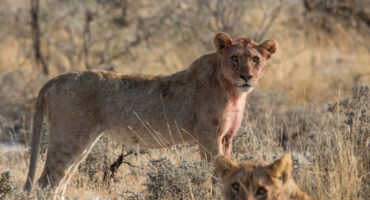
Custom Safaris in Namibia
Ready to Book Your Custom Safari Tour in Namibia?
Sprawling across southwest Africa, Namibia is a country with vast tracts of wide-open spaces under densely star-filled desert skies. Ancient and ambitious, this young country is home to some of the last nomadic tribes and some of the most pioneering conservation initiatives. We especially love how Namibia makes elephants seem small. Among endless miles of the most rugged and stark terrain, a great guide will show you how life thrives from desert adapted megafauna to thousand year old plants.
Obtaining its independence only in 1990, Namibia was the first country to include environmental and wildlife protection in its constitution. The country has great natural treasure to protect: seal colonies, flamingos, cheetah, oryx, Hartmanns zebra, desert-adapted rhino and elephants and much more. Attractions include the grand and spectacular orange dunes of Sossussvlei, shipwrecks along the Skeleton Coast and the pans of Etosha National Park.
Namibia Safari Overview
Namibia is a large country even by African standards. About twice the size of California, its population is just 2 over million, one of the lowest densities in the world. There’s a lot of open space and breathtaking landscapes. Over the last few years, Namibia’s popularity has exploded, and it is a now a well-known safari destination famed for its remote and intimate lodges, fascinating indigenous culture and pioneering community-centric conservation as well as splendid wildlife in spectacular desert ecosystems.
The Namib Desert is the world’s oldest desert and indeed the country feels like an ‘ageless land’. This quality is reflected in rock art created by stone-age artists at sites like the world-famous Twyfelfontein and in its geological attractions like a petrified forest of fossilized tree trunks over 280 million years old. Combined with vast dunes and silence, there’s a feeling of antiquity, solitude and wilderness.
The climate is typical of a semi-desert country. Days are warm to hot and nights are generally cool. Temperatures are modified by the high plateau in the interior and by the cold Benguela Current that creates cooling fogs along the Atlantic coastline. Except for the first few months of the year, the country is generally dry with very little rain.
We generally recommend a minimum of 8-nights to experience Namibia’s highlights like Sossusvlei, Etosha National Park and the adjacent Ongava Reserve, the Skeleton Coast and Damaraland to mention a few. Camps and lodges throughout Namibia are most-efficiently linked with scheduled or charter flights. Namibia is large so overland road transfers between regions are possible but involve long drives. With safe, good quality roads, self-driving itineraries are a wonderful way for experienced safari travelers to explore Namibia.























